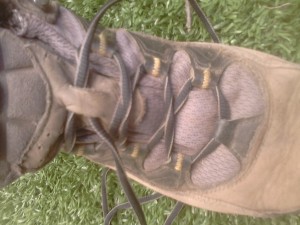How to choose hiking boots

How to choose hiking boots
Posted on
Choosing the correct hiking boot is the most important purchase decision for us walkers. Get it wrong and you will literally regret it every step.
Team Inspiration Outdoors goes through a fair few kilometres each year and we tend to push our gear to the limits. Here is what we have learnt about how to choose hiking boots.
1. Walk to the store
This is a simple but great tip. Your feet will swell up on a long walk, so when you put them on in the shop and they feel fine, will they feel the same after 5 kilometres? The only way to know is to walk to the store so that you have sufficiently swollen feet when trying the boots on for size.
2. Nothing is more important than fit
Buying boots is not like buying a pair of stilettos where you might suffer some comfort for fashion. You have to get the fit right otherwise it can ruin your holiday. Would you rather wear an overly tight pair of $400 Gortex boots or a $100 pair of joggers on a 20 kilometre walk? I would take the joggers any day of the week. The way to ensure you get the right fit is to test your prospective boots out vigorously. A proper outdoors shop will have some stairs or ramps for you to put your boots through their paces. In particular walk up and down stairs. Often boots feel good on the flat, but will slip or dig in going up and down stairs.
If you have trouble finding shoes that fit, always err on the too big side. You can always double sock but shrinking the feet requires an awkward trip to the witch doctor!
3. Pay attention to the little things
Below are photos of my last three pairs of boots. First up you have the Scarpas. Great boots. Very expensive but made to the highest quality. Notice the eyelets where the laces go? They are made from metal which will last for ever but is heavy. I don’t wear these boots any more because they are far to heavy for Australian conditions. Perfect for the Himalayas where you need warmth and hard core ankle support.
Next up, are my Keens. These fitted beautifully and I thought I was on a real winner for the first six months. But here they are now, completely useless less than 9 months (approx 500km) after purchase. See the eyelets on these are made from cheap and weak fabric. The shoelaces ripped through in no time and they are not economically repairable.
The final pair are my new Salomon boots. I have gone back to Salomon despite the expense because Salomon do things right. The eyelets (by way of example of the quality of the whole boot) are made from a a thick leather with reinforced stitching, which makes it not only tough but light.
It really pays to look closely at the prospective boot and ask, what is going to break on these things first? The answer should always be, I will wear the sole off before anything else breaks.
4. Ankle support or not
I am not really sure why they make low cut walking boots. I always recommend a mid or high cut. You don’t have to be scaling mountains or rock hoping on the Larapinta to benefit from some additional ankle support. High cut boots won’t necessarily prevent slips and trips but they will certainly mitigate the effects.
One thing that people tend to ignore is you can improve your ankle support (on a mid/high cut) just by ensuring the boot is done up nice and tight at the ankle. In fact this is how I lace up my boots always. Tight at the ankle and looser over the top of the foot.
5. Water proofing
Unless you live in the tropics where the walking season is the dry, you are going to want some level of water proofing for your boots. Some boots have a lot of thin, porous mesh on them which just lets the water in. Why do they do this!!?? Go for a boot that has mostly non porous surface. It is never going to prevent water getting in if you are crossing a river, but it will stop the rain from getting in.
The final word on how to choose hiking boots
A good pair of boots should last at least 1000 kilometres. My first pair of Salomon boots did more than double this and only died when I left them too close to the fire. I still cry about this from time to time.
Really take your time to look at the boot and decide, “are these made to a high quality?” Remember, you will push these boots a lot more than a standard sneaker which you wear around the burbs.
My latest pair of boots were around the $250 mark which is a lot for a boot but a price I will happily justify. There are some okay quality boots around the $150 mark but if your budget can’t stretch to this, then I would just go for a good quality jogger instead.
So there you are. Our guide on how to choose hiking boots. If you have any comments, please leave them below as we would love to hear from you.






